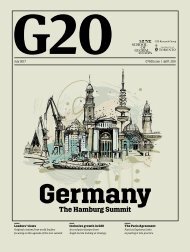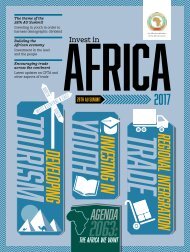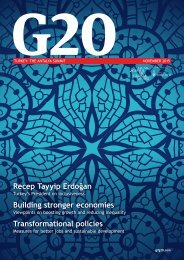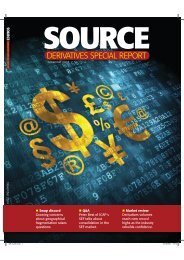G20 china_web
Create successful ePaper yourself
Turn your PDF publications into a flip-book with our unique Google optimized e-Paper software.
Investing in infrastructure<br />
It is a member of the <strong>G20</strong>'s Global<br />
Infrastructure Connectivity Alliance<br />
Its Capability Framework will be<br />
publicly available from early 2017<br />
DAVID GRAY/REUTERS/ALAMY<br />
IMAGE SOURCE<br />
Workers underneath a railway bridge<br />
building project in Beijing, China<br />
The GI Hub<br />
has been asked<br />
to provide<br />
leadership on<br />
the knowledge<br />
agenda<br />
$20TR<br />
The global economy's estimated<br />
infrastructure deficit by 2030<br />
incentives with regard to crowding in<br />
private finance and to report to our Deputies<br />
in December 2016”. This is a key priority for<br />
the GI Hub, with MDBs uniquely placed to<br />
catalyse further inflows of private finance<br />
into infrastructure. MDBs are present<br />
on the ground in many countries and<br />
are trusted partners. They have project<br />
preparation facilities to support learning<br />
and good processes and they have financial<br />
and guarantee-based products to support<br />
private sector investment. With their scale,<br />
they are ideally placed to take a leadership<br />
role in ensuring that lessons learned are<br />
generalised within countries, helping to<br />
reduce the barriers to investment preventing<br />
many countries from progressing.<br />
Partnerships and assessment<br />
The difficult area of cross-border projects<br />
was a further priority of the Chinese<br />
presidency. Together with the World<br />
Bank, which will provide the secretariat,<br />
and the Organisation for Economic Cooperation<br />
and Development, the GI Hub<br />
is a member of the Global Infrastructure<br />
Connectivity Alliance, which was launched<br />
by <strong>G20</strong> finance ministers and central<br />
bank governors on 24 July. The GI Hub<br />
has been asked to provide leadership<br />
on the knowledge agenda relating to the<br />
financing of infrastructure. It will also look<br />
to include connectivity-related literature<br />
in its knowledge-sharing resources and<br />
connectivity-focused projects on its<br />
project pipeline.<br />
In partnership with EDHECinfra in<br />
Singapore, the GI Hub has also recently<br />
released a survey assessing the attitude<br />
towards and appetite for investment by<br />
infrastructure investors and advisers.<br />
Important findings included that 65 per<br />
cent of investors are looking to increase<br />
their exposure to infrastructure and more<br />
than 90 per cent are concerned by the<br />
lack of opportunity. Encouragingly, there<br />
is strong investor appetite for emerging<br />
market infrastructure.<br />
Providing forecasts<br />
During the next six months, three priorities<br />
for the GI Hub are the release of the<br />
Infrastructure Needs Assessment, the initial<br />
iterations of the Capability Framework and<br />
the Global Project Pipeline.<br />
The Infrastructure Needs Assessment<br />
will be a comprehensive estimate of 50<br />
key countries, with a global overview.<br />
It will provide detailed global, regional<br />
and country-level forecasts of annual<br />
infrastructure spending, needs and<br />
gaps, up to 2040. The estimates will be<br />
separated by infrastructure sector –<br />
water, power, transport, telecoms – and<br />
will account for the United Nations<br />
Sustainable Development Goals and the<br />
Paris Agreement on climate change. The<br />
assessment will be designed for the public<br />
and private sectors as a platform for policy<br />
reform and investment analysis.<br />
The Capability Framework, which will<br />
be publicly available in early 2017, will<br />
provide a detailed analysis of the capability<br />
of individual countries to undertake<br />
infrastructure development, focusing<br />
particularly on the investment environment,<br />
government capability, public and private<br />
financing, and infrastructure markets. It will<br />
identify the strengths and weaknesses of<br />
existing legislation and frameworks, so as<br />
to help countries maximise their appeal to<br />
private investors.<br />
Pipeline launch<br />
The GI Hub’s Global Infrastructure<br />
Project Pipeline initiative, which is being<br />
undertaken in response to a specific<br />
mandate from the <strong>G20</strong>, is designed to meet<br />
the private sector’s need for a consolidated<br />
and standardised global database of<br />
prospective infrastructure projects. The<br />
pipeline will present prospective projects<br />
using a common format, to assist users<br />
to make comparisons across countries,<br />
sectors and projects. It will include<br />
advance visibility of upcoming government<br />
projects, and will provide an opportunity<br />
for countries to market their infrastructure<br />
projects broadly on a global platform.<br />
The GI Hub is aiming to have the<br />
pipeline launched with a select number<br />
of initial governments by the end of the<br />
year, with additional countries joining the<br />
pipeline throughout 2017. Like all the GI<br />
Hub’s products, it can be used by both <strong>G20</strong><br />
members and all other countries. In 2017,<br />
as well as focusing on deployment of these<br />
various tools, the GI Hub will continue to<br />
develop other new products to help deliver<br />
on its mandate. <strong>G20</strong><br />
G7<strong>G20</strong>.com September 2016 • <strong>G20</strong> China: The Hangzhou Summit 135
















